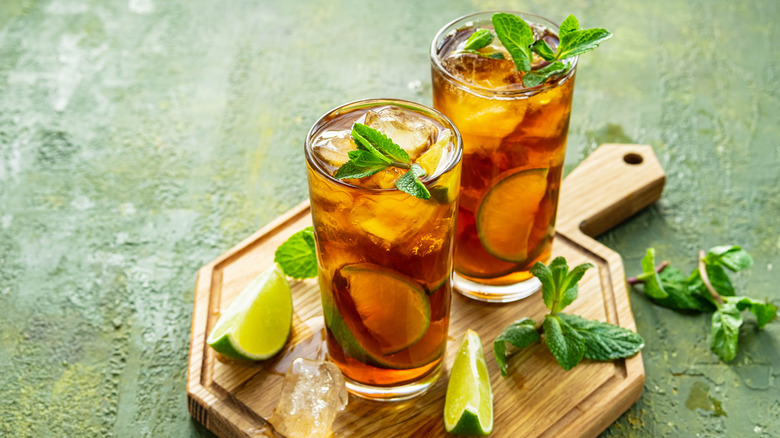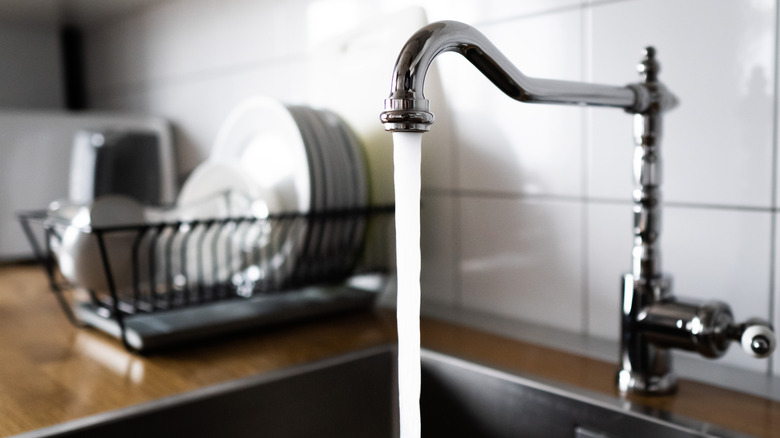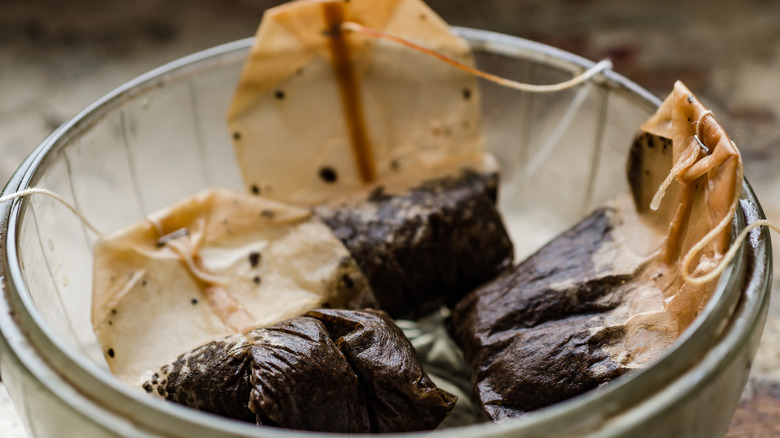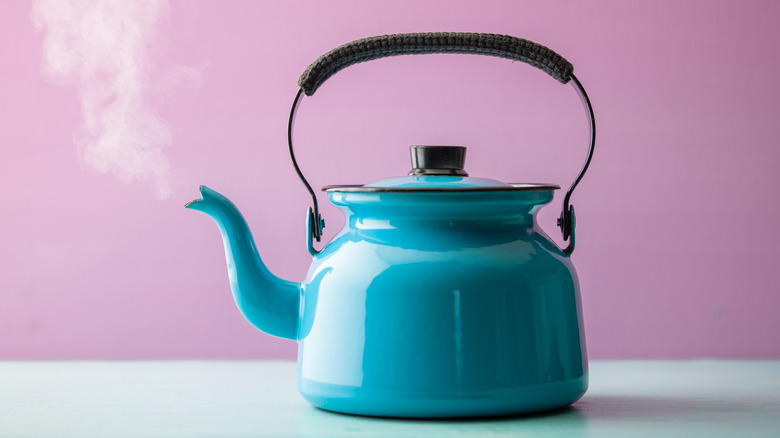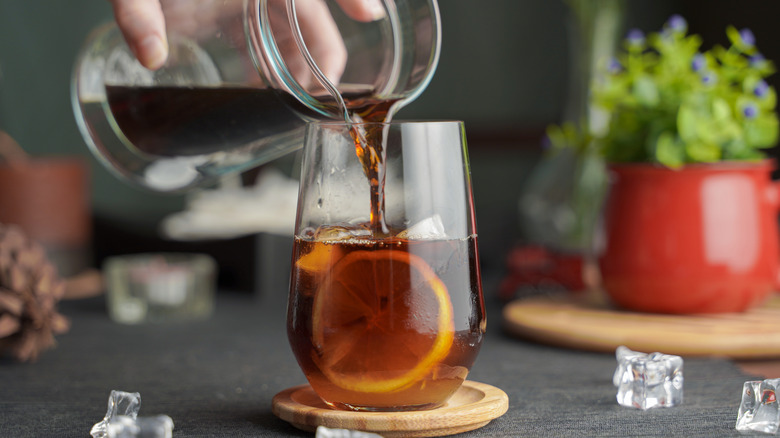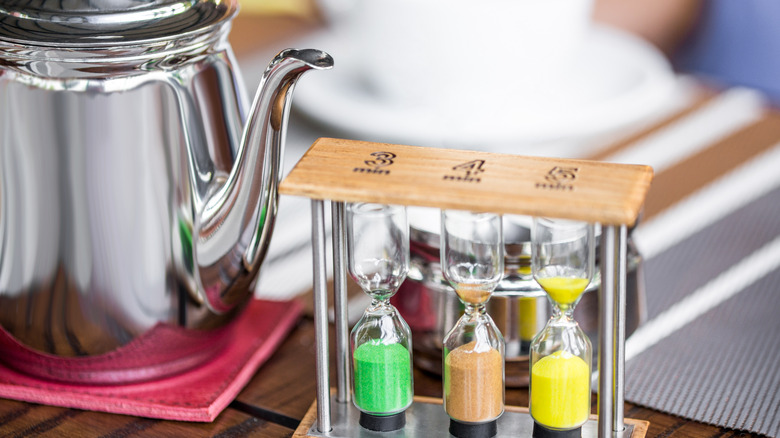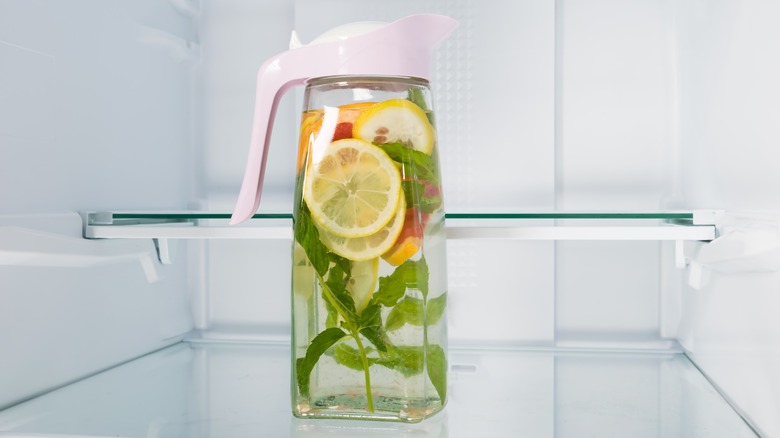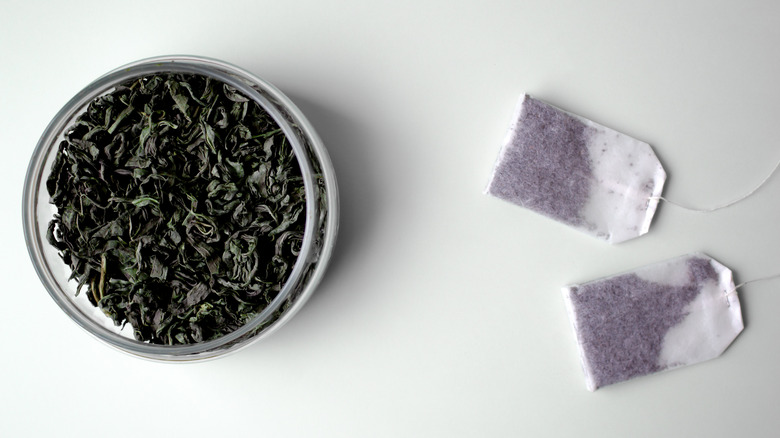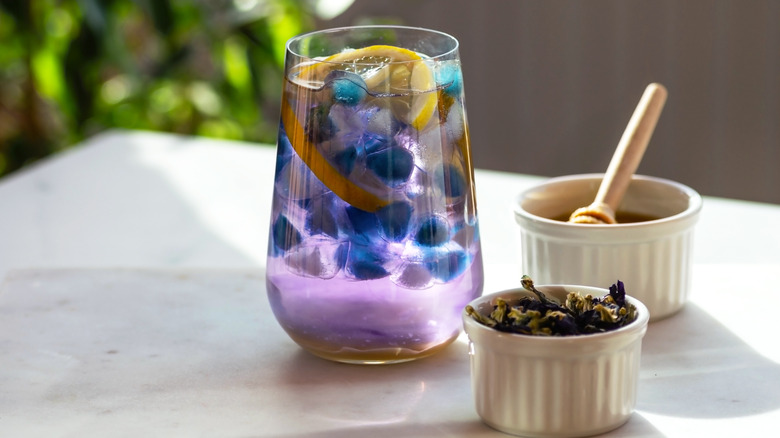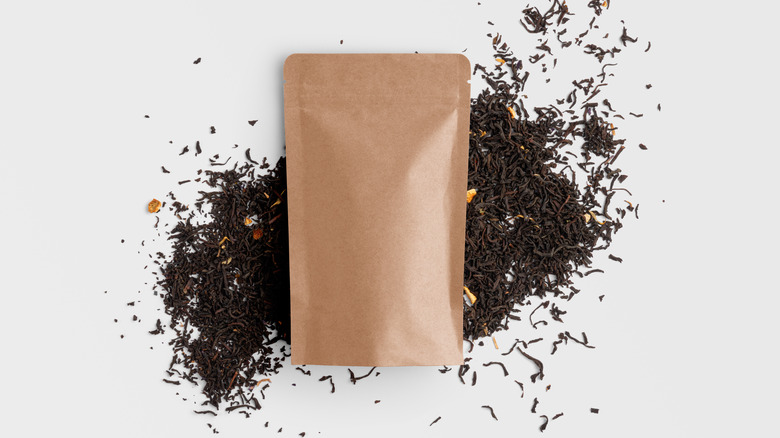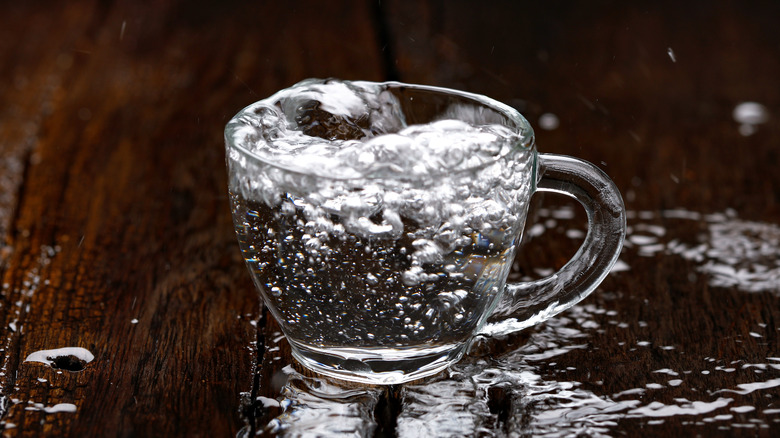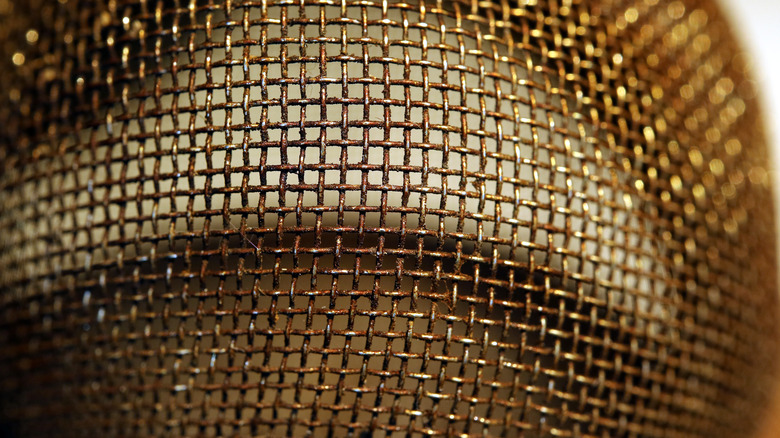Mistakes Everyone Makes When Preparing Iced Tea
With the arrival of warmer weather, you might be opting for more refreshing drinks as opposed to hot and hearty beverages like hot chocolate, apple cider, or hot coffee. Instead, bubbly drinks, iced sodas, and iced tea are probably making a move into your daily drink repertoire. And why not? Iced tea is a great way to stay hydrated, especially if you have trouble finding the time to drink water (via Everyday Health).
Iced tea, just like hot tea, is packed full of antioxidants and polyphenols. It's also simple to brew ... for the most part. Sometimes it doesn't seem to work out so well though; maybe your tea has no flavor, or perhaps the flavor is so bitter that your brew is destined to be plant food. It might even have a cloudy appearance. As with hot tea or cold brew coffee, there are a number of variables that could be contributing to a lackluster brew.
If you've ever run into any of these issues, don't despair. Knowledge is power, and learning from your mistakes is part of the process. Once you're armed with the tools to fix them, you won't need to worry about a less-than refreshing glass of iced tea.
Using subpar water
Have you ever had water that tastes a bit off or smells like chemicals? Now imagine making tea with that funky water. Water quality has a direct influence on the way your iced tea is going to turn out. In an experiment done by Serious Eats, four different types of water were used to make both green and black tea: tap, filtered, and two types of bottled water. While tea quality also played a major role in how the final product tasted, the results concluded that "If you wouldn't drink your tap water as water, don't brew it as tea."
Perfect Daily Grind notes that poor water has an effect on the way your tea tastes. The outlet went to give a general profile as to what your drink is supposed to taste like — that's called dedication. Green tea should taste like grass, butter, and vegetables, while Darjeeling will have grape, citrus, and muscat flavors.
If you're concerned about your water quality, you can always contact your local water district. They should be able to provide you with all the information you need about your municipal water. The U.S. Environmental Protection Agency also has multiple reference pages on water quality so you can find out if yours is up to par.
Using low-quality tea
So, what exactly defines tea quality? Well, it's more than just the price you paid at your grocery store or coffee shop. Path of Cha writes that when it comes to loose-leaf tea, there are certain standards that need to be met in order for it to be considered of high caliber. For starters, whether the farm uses sustainable practices and honors human rights is an important factor to consider.
Path of Cha also highlights that the leaves should be whole, uniform, and free from tears. The location of the tea farm, as well as when the leaves are cultivated and harvested, are also relevant. This is because tea leaves picked in the early spring are generally smaller and daintier and are considered more valuable compared to larger ones. Lastly, packaging and storage are important, because if fermented tea isn't stored properly, moisture can enter and grow mold (via Path of Cha).
Those are the basics, but Red Blossom Tea Company says that it comes down to taste, convenience, and sustainability. In fact, loose-leaf teas aren't always of better quality. The outlet explains that mass-produced tea commonly has fillers like herbs, flowers, and crushed-up leaves labeled as tea blends. Big box tea companies sometimes use pesticides and fertilizers to speed up the growth process. So, if you see organic or fair trade on your tea box, chances are that it's a better quality tea.
Brewing temperature that don't line up with the tea type
With hot tea, it's important to note that the water temperature can make or break the flavor. This is because different types of tea (green, white, red, black) require different steeping times and temperatures (via Path of Cha). The general rule of thumb is that darker types like black tea, black tea blends, and oolong tea can stand up to hotter temperatures. Meanwhile, their more delicate siblings (green and white teas) require the exact opposite. This all stems from the way the tea leaves were initially processed to produce the final outcome, UptonTea explains.
So, if you're going to brew some green tea for iced tea, you shouldn't just haphazardly pour boiling water over those unsuspecting tea leaves. The extreme heat will shock the leaves, causing them to release our least favorite-flavored polyphenol: tannic acid (via Tea Leaf Journal). That's why it's important to become familiar with different types of teas and the temperature they require for optimal brewing.
Using the wrong brewing method
While all tea can be made into an iced version, Sipsby reports that black tea has traditionally been the primary choice. Once you pick your tea, there are three common methods to prepare the iced style: hot brewing (the classic way), cold brewing (the innovative way), and brewing by the rays of the sun (the hippie way). Hot brew tea requires you to first brew an extra-strong batch of hot tea using a ratio of two teaspoons of tea per six to eight ounces of cold water, according to Golden Moon Tea. Once it's brewed, pour the tea over a pitcher of ice.
For cold brew iced tea, use one tea bag (or one teaspoon of loose-leaf) per six to eight ounces of water (via Cookie and Kate). Put a lid on your tea vessel and let it hang out in the fridge; soaking times vary depending on the type of tea. For sun tea, fill a clear sterilized two-quart jar with water, add in four tea bags (or four teaspoons of tea), and let it steep in the sun's golden rays for up to four hours (via Simply Recipes).
Steeping for too long or too little
You can't just toss your tea into a pitcher, fill it with water, and let it sit for however long you want. If only it were that easy. However, if you steep your tea for too long, it can end up tasting bitter and acrid, and it will suck the moisture out of your mouth. This is one reason why so many people are led to believe that they hate iced tea (or tea in general).
You can thank Camellia sinensis — the scientific name for the tea plant, per Britannica — for that disgusting taste. It's called tannic acid, which Tea Leaf Journal explains is a naturally occurring polyphenol found in all dried tea. Since herbal tea is made from herbs instead of tea leaves, it doesn't contain any.
The longer you steep, the more tannins are released into your iced tea, which is why timing is so important. For the unconventional cold brew method, Cookie and Kate notes that green and white teas only need six to eight hours of soak time, while black and oolong teas require eight to 12 hours. Meanwhile, for the hot brew tea method be sure to follow the steeping times indicated on the packaging.
Not letting it chill out
This rule only applies to the traditional hot brewing method, so purists listen up. Have you ever been to a picnic or barbecue where someone brought homemade iced tea with a rather questionable appearance? As in, the tea looked like it could just as well be stagnant pond water instead of iced tea. Yeah, that person missed this step.
Cloudy water isn't going to have an effect on taste, but it does come off as incredibly unappetizing. To prevent this from happening to you, just make sure that once you have steeped your double-strength batch of tea, you remove the tea bags. Then, allow the tea to cool to room temperature before adding in the extra six to eight ounces of cold water. By giving your tea the chance to chill, the tannins and caffeine can't mingle, which Southern Living indicates will eliminate the risk of your iced tea looking all muddled, murky, and cloudy.
Using stale tea
While tea doesn't exactly go bad, it can most definitely become dull, muted, and ultimately brew into a cup of flat-tasting sadness. So when it comes to keeping your tea as fresh as possible, you can boil it down to these four factors: too much light, air, heat, and time.
Lacademie also states that different types of tea have varying shelf lives. Both black and oolong tea are fermented the longest, and black tea has a shelf life of more than 18 months (up to three years). Oolong has a shorter fermentation time and can survive up to two years, though properly storing it will prolong the time. Meanwhile, green tea pretty much taps out at 18 months. White tea can hold its flavor for up to two years, or 20 years if you're looking to maximize its medicinal qualities, Lacademie explains.
So, how do you tell if your tea is a no-go? First, visually inspect it for mold; if there's mold, it doesn't move on to the next round. Next, smell the tea. If you're getting funk and mildew, into the compost bin it goes — you don't need that in your life. If your tea has no aroma whatsoever, then your brew will taste like nothing. Do not pass go, do not collect $200, that tea is a goner. But if it smells fine, then give it a whirl. The worst that could happen is that your tea tastes watery and lifeless.
Not experimenting with infusions
A lot of people new to the iced tea scene assume that lemon is the only extra you can mix in. Lucky for your taste buds, that's not the case. You can use pretty much any fruit, herb, flower, or water-based vegetable to add a nice little kick to your water (via Spoon University). If adding fruits, veggies, or herbs can make water taste more palatable, then imagine how it could enhance tea-infused water?
If you're the type of person who likes tea with their sweetener — completely understandable since flavorless or tannic tea is less than appealing — consider using infusions as a sugar (or honey) stand-in. Not only will it naturally sweeten up your brew, but you'll also be reaping the benefits of the aforementioned without actually eating them. (Not that getting a few servings of fruits and veggies ever hurt anyone, right?)
Simple Loose Leaf makes a good point that ripe fruit has a more intense flavor. When it comes to pairing tea and fruit, black teas sync well with orange, lemon, pineapple, and passion fruit. Green teas hold up well with strawberries, blueberries, and kiwis, while white tea is incredibly delicate and goes well with different types of pears.
Improperly storing your tea
Remember that too much light, heat, moisture, and air will make you say ta-ta as you send your tea down the drain. Basically, if your tea is over-exposed (or exposed at all) to the elements, it will begin to break down and lose its potency. To prevent that from happening, start by making sure that you always store your tea in a tightly sealed container. Té Company Tea recommends using an airtight canister that blocks light and doesn't absorb smells. So that super cool mason jar you recently thrifted won't work.
Once you have the right container to house your tea, the next step is figuring out where it should live. It's airtight and lightproof, so any random place on your kitchen counter should be fine, right? Wrong. Tea Crossing reminds tea drinkers that cool, dark places are the best spots to store the container. Consider your pantry, cupboards, or somewhere tucked away on your kitchen counter that's out of direct sunlight.
While you can technically, store your container of tea on the countertop, keep it far, far away from your appliances. And don't put it on top of your refrigerator because — everyone all together now — hot air rises. Your tea canister will get all toasty warm and either do a nice low n' slow roast or even worse ... if moisture somehow got in there, you'll grow a mold farm.
Using an incorrect water to tea ratio
Making iced tea can be a science, but it's a relatively easy task once you get the hang of it. One of the major issues people tend to run into is the amount of tea and water they should be using. Normally, you just grab a random pitcher, toss in some teabags, and hope for the best, right? Or maybe you follow the instructions that are (thankfully) located on the back of your tea's packaging.
Whatever methodology you choose to use, in order to make a successful pitcher of iced tea, you're going to want to follow some basic ratio guidelines. Lucky for you, Food Network has it all laid out — and it's pretty simple. You'll need to take into consideration the type of brewing method you're going to use, though, as well as whether your tea is bagged or loose-leaf.
For hot brewed iced tea using tea bags, a ratio of six teabags to eight cups of water is ideal. For loose-leaf, you'll do three tablespoons to eight cups of water. Now, if you're utilizing the cold brewing method, you're going to need 10 teabags (per eight cups of water) or six tablespoons for loose-leaf. Easy-peasy — just don't forget that each tea has a specific brew time.
Not using clean equipment
When you're finished with a meal, do you normally just rinse your dishware with water, let it dry, and then put it away even if there's still food on it? Probably not. Any food particles that aren't caked onto your dish most definitely will be once the air sucks all the moisture out of it. That old food has the potential to grow bacterial and make you sick, as noted on FoodSafety.gov.
Besides being a potential health hazard — and possibly inviting unwanted guests into your home — leaving food on your plate can also add unexpected flavors to whatever you're consuming next. Teasteeping states that it's important to thoroughly clean any equipment you're using to brew your tea. Strainers and other materials can absorb smells, flavors, and oily residues when you brew tea. In particular, porous materials like plastic tend to soak up every smell that comes in contact. Redditors recommend using an acid (like vinegar or lemon juice) mixed with hot water as a soak to deep clean your brewing equipment.
